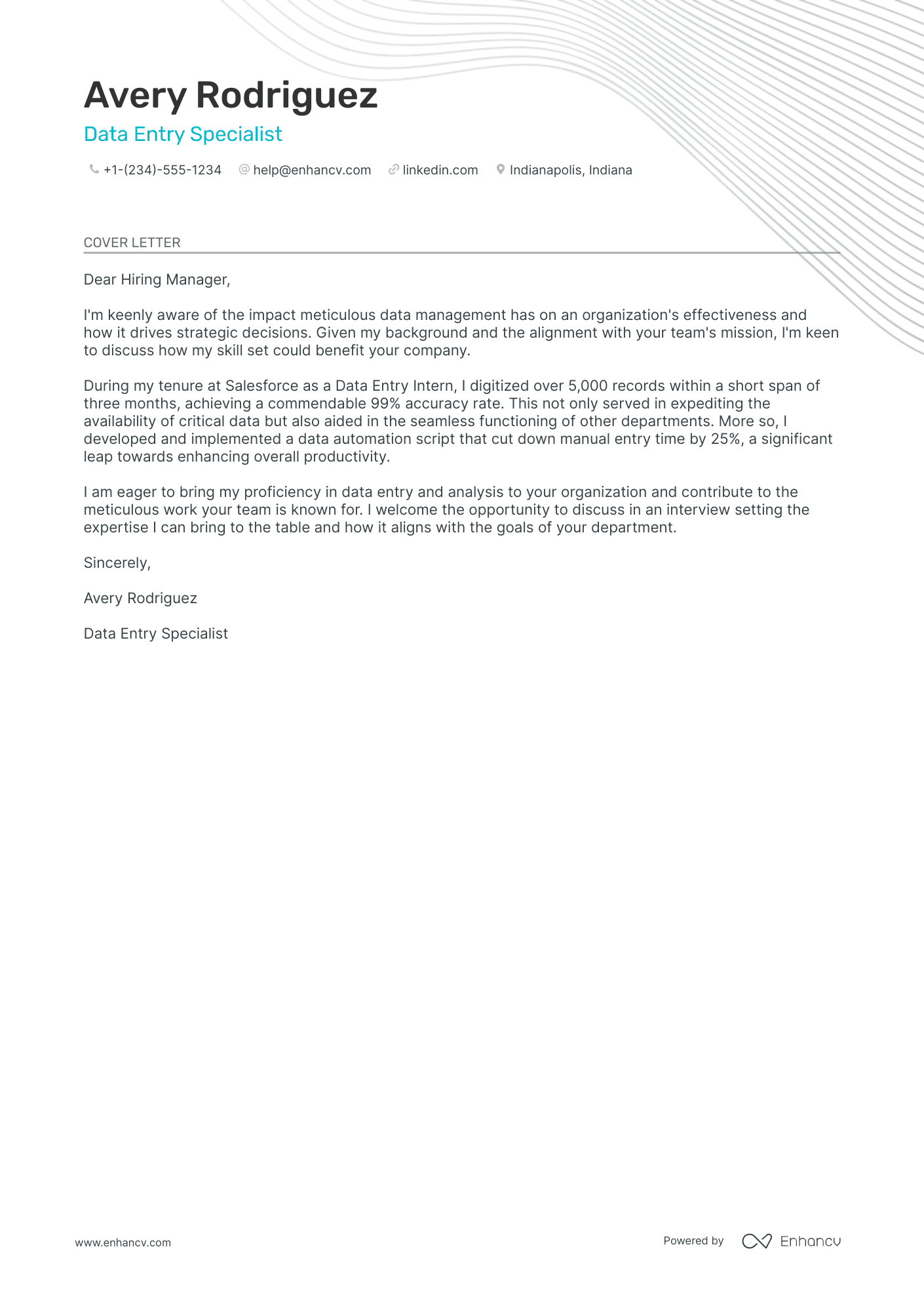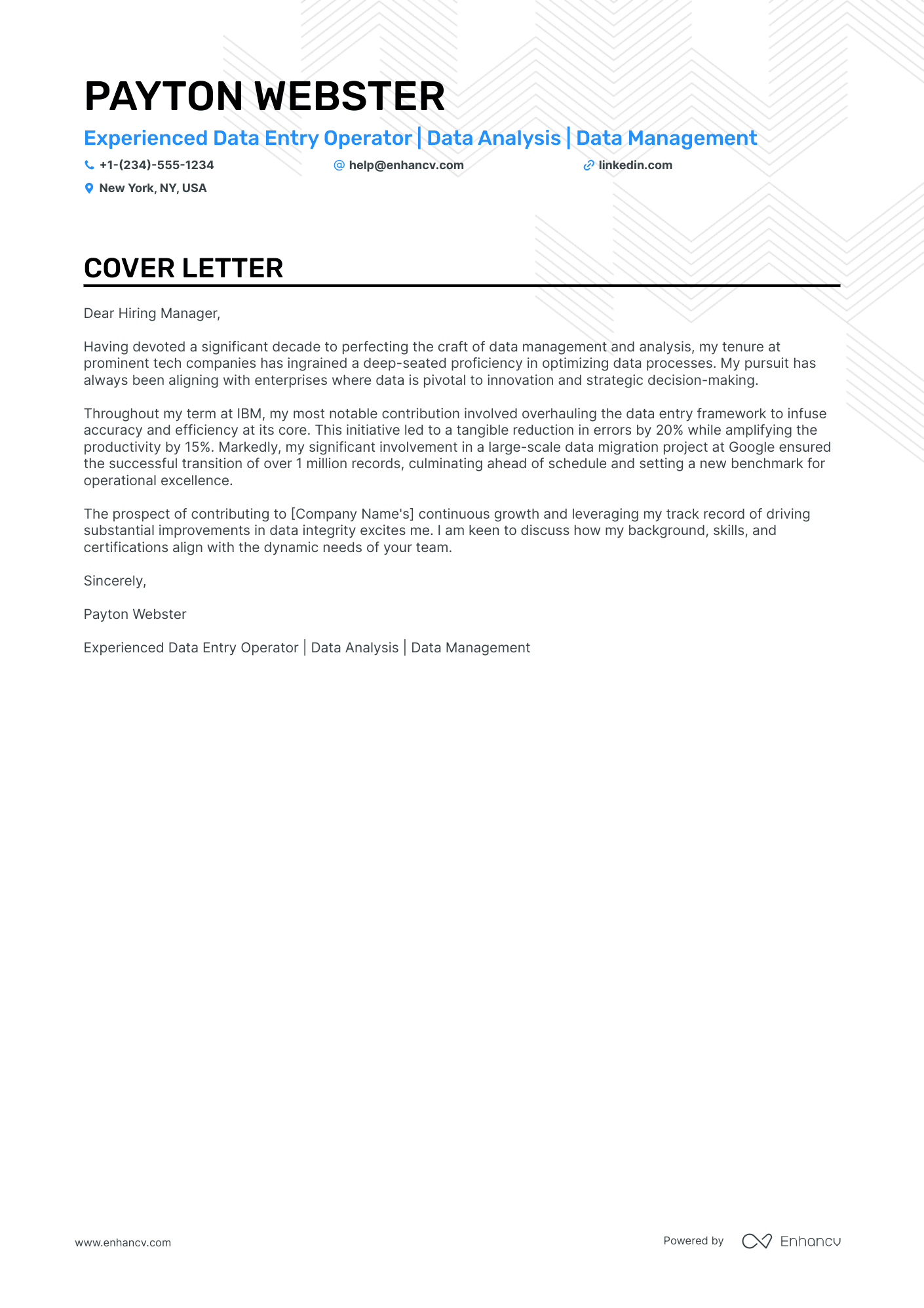Crafting a data entry cover letter can often be a stumbling block on your path to landing that desired job. You've diligently updated your resume and started applying, only to realize a persuasive cover letter is also a must. It's not about rehashing your resume; instead, it's about showcasing your crowning professional achievement through a compelling narrative. Strike a balance between formality and fresh language, steering clear of worn-out phrases, all while keeping it concise—limited to just one page.
- Write a data entry cover letter that helps you stand out (and get the job);
- Understand how to start and end your data entry cover letter with the appropriate greeting;
- What to include in the body of your data entry cover letter to put your best foot forward;
- Your most important achievements - how to present them as part of your data entry cover letter.
And if you want to make your life even easier, simply drag and drop your data entry resume into Enhancv's AI cover letter generator, and it will write your cover letter for you in just a few moments.
If the data entry isn't exactly the one you're looking for we have a plethora of cover letter examples for jobs like this one:
- Data Entry resume guide and example
- Administrative Associate cover letter example
- Senior Administrative Assistant cover letter example
- Executive Assistant to CEO cover letter example
- Administrative Manager cover letter example
- Front Office Manager cover letter example
- Administrative Assistant cover letter example
- Household Personal Assistant cover letter example
- Office Manager cover letter example
- Front Desk Supervisor cover letter example
- Guest Services Manager cover letter example
Drop your resume here or choose a file.
PDF & DOCX only. Max 2MB file size.
Data entry cover letter example
Ethan Smith
Phoenix, Arizona
+1-(234)-555-1234
help@enhancv.com
- Highlighting quantifiable achievements (such as the "25% reduction in errors" and "monthly salvage of over 100 hours") provides concrete evidence of the candidate's capability and experience, which is crucial for a role that values accuracy and efficiency.
- Demonstrating the adoption and integration of new software tools shows adaptability and a forward-thinking approach to technology, which is important in roles like Data Entry where staying current with latest tools can drive efficiency.
- Emphasizing leadership roles in process improvements (like leading the adoption of new verification processes or creating new database structures) positions the candidate as a proactive and valuable contributor who can enhance team performance in a data management context.
Designing your data entry cover letter: what is the best format
Let's start with the basics, your data entry cover letter should include your:
- Header
- Greeting
- Introduction
- Body paragraph
- Closing statement
- Signature (that's not a must)
Next, we'll move to the spacing of your data entry cover letter, and yes, it should be single-spaced (automatically formatted for you in our cover letter templates).
Don't go for a old-school font (e.g. Arial or Times New Roman), but instead, pick an ATS-favorite like Chivo, Volkhov, or Raleway, to stand out.
Our cover letter builder is also set up for you with the standard one-inch margin, all around the text.
Finally, ensure your data entry resume and cover letter are in the same font and are submitted in PDF (to keep the formatting in place).
P.S. The Applicant Tracker System (or ATS) won't be assessing your [job] cover letter, it's solely for the recruiters' eyes.
Don’t let cover letters slow you down. Use our free cover letter generator to create one in no time.
The top sections on a data entry cover letter
- Header: Includes your contact information and the date, making it easy for the recruiter to know who you are and how to contact you.
- Greeting: Addresses the hiring manager or recruitment team specifically, demonstrating that you have researched the company and personalized your application.
- Introduction: Briefly states the position you are applying for and gives a compelling reason why you are interested in data entry at their company, setting the stage for your letter.
- Professional Experience and Skills Body: Highlights your data entry experience, typing speed, attention to detail, and familiarity with relevant software, which are critical skills for the role.
- Closing and Call to Action: Ends the letter on a polite note, reiterates your enthusiasm for the role, and expresses your eagerness to discuss how your data entry skills align with the company's needs in an interview.
Key qualities recruiters search for in a candidate’s cover letter
Attention to Detail: Essential for ensuring accurate and high-quality data input, minimizing errors, and maintaining the integrity of the data.
Typing Speed and Accuracy: Important for efficiently handling large volumes of data entry while maintaining high accuracy levels to meet productivity targets.
Familiarity with Data Entry Software: Knowledge of specific data entry programs like Microsoft Excel or database management systems indicates that the candidate can start with minimal training.
Discretion and Confidentiality: Data entry often involves handling sensitive or private information, making the ability to maintain confidentiality crucial.
Excellent Organizational Skills: Helps in managing data systematically, tracking tasks, and prioritizing work to meet deadlines and maintain a well-organized database.
Ability to Concentrate for Long Periods: Shows the candidate's capability to stay focused on repetitive tasks, reducing errors, and maintaining consistent performance over time.
What greeting should you use in your data entry cover letter salutation
A simple "Hello" or "Hey" just won't work.
With your data entry cover letter salutation, you set the tone of the whole communication.
You should thus address the hiring managers by using their first (or last name) in your greeting.
But how do you find out who's recruiting for the role?
The easiest way is to look up the role on LinkedIn or the corporate website.
Alternatively, you could also contact the organization via social media or email, for more information.
Unable to still obtain the recruiter's name?
Don't go down the "To whom it may concern path". Instead, start your cover letter with a "Dear HR team".
List of salutations you can use
- Dear Hiring Manager,
- Dear [Company Name] Team,
- Dear [Department Name] Hiring Committee,
- Dear Mr./Ms. [Last Name],
- Dear Dr. [Last Name],
- Dear [Professional Title],
Introducing your profile to catch recruiters' attention in no more than two sentences
The introduction of your data entry cover letter is a whole Catch 22 .
You have an allocated space of no more than just a paragraph (of up to two sentences). With your introduction, you have to stand out and show why you're the best candidate out there.
Set out on a journey with your data entry cover letter by focusing on why you're passionate about the job. Match your personal skills and interests to the role.
Another option for your data entry cover letter introduction is to show you're the ideal candidate. Write about how your achievements and skills are precisely what the company is looking for.
However you decide to start your data entry cover letter, always remember to write about the value you'd bring about. Making it both tangible (with your metrics of success) and highly sought out.
The middle or body of your data entry cover letter body: a great instrument to tell a story
Now that you've set the right tone with the greeting and introduction of your data entry cover letter, it's time to get down to business.
Hear us out, the body of your data entry cover letter is the best storytelling instrument you have, in your job-hunting arsenal.
Writing the next three to six paragraphs, take the time to reassess the advert to discover job-crucial requirements.
Next, choose one accomplishment that covers those key skills and talents.
Use precisely that achievement to tell an exciting story of how you match the ideal candidate profile.
In the undertones of your story or data entry cover letter body, hint at the difference you'd make and sell your application as the perfect one for the job.
Two ideas on how to end the final paragraph of your data entry cover letter
Closing your data entry cover letter, you want to leave a memorable impression on recruiters, that you're a responsible professional.
End your cover letter with how you envision your growth, as part of the company. Make realistic promises on what you plan to achieve, potentially, in the next six months to a year.
Before your signature, you could also signal hiring managers that you're available for the next steps. Or, a follow-up call, during which you could further clarify your experience or professional value.
The zero experience data entry cover letter: shifting the focus to your unique value
Don't worry if you have no conventional professional experience. Within your whole experience, there's plenty more you can write about in your data entry cover letter.
Take, for example, your biggest achievement or award - dedicate your cover letter body to describe it and the job-relevant skills you've learned.
Your professional ambitions could also take center stage. Describe what you plan on achieving in the next five to ten years and the efforts you're making towards your dreams.
Key takeaways
We hope this data entry cover letter writing guide has shown you how to:
- Format your data entry cover letter with the mandatory sections (e.g. header, greeting, intro, body, and closing) and select the right font (P.S. It should be the same as the one you've used for your resume);
- Substitute your lack of professional experience with your most noteworthy achievement, outside of work, or your dreams and passions;
- Ensure recruiters have a more personalized experience by tailoring your cover letter not just to the role, but to them (e.g. writing their first/last name in the salutation, etc.);
- Introducing your biggest achievement and the skills it has taught you in your data entry cover letter body;
- Write no more than two sentences in your data entry cover letter introduction to set the right tone from the get-go.
Data Entry cover letter examples
By Experience
Entry-Level Data Entry
By Role





















